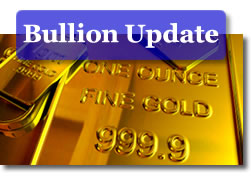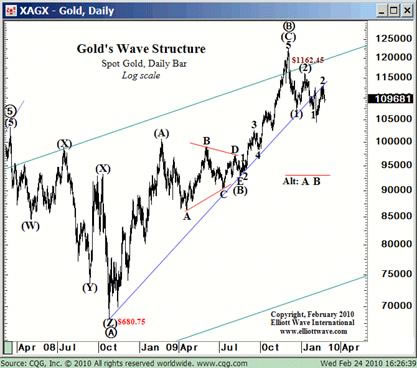 Gold finished higher for the first time this week on Thursday, benefiting from a dollar that began the day strong but weakened in the afternoon. Concerns resurfaced early over Greece’s debt crisis, which pressured the euro lower and the dollar higher. Gold tends to move in the opposite direction of the greenback.
Gold finished higher for the first time this week on Thursday, benefiting from a dollar that began the day strong but weakened in the afternoon. Concerns resurfaced early over Greece’s debt crisis, which pressured the euro lower and the dollar higher. Gold tends to move in the opposite direction of the greenback.
Crude tumbled 2.3 percent. Demand concerns following higher than expected weekly jobless claims and the aforementioned Greece problems were cited catalysts for oil’s retreat and for a slight dip in U.S. stocks.
New York precious metal figures follow:
-
Gold for April delivery rose $11.30, or 1.0 percent, to $1,108.50 an ounce. The yellow metal ranged from $1,088.50 to $1,110.00.
-
Silver for May delivery gained 16.9 cents, or 1.1 percent, to close at $16.132 an ounce. It ranged from $15.630 to $16.175.
- April platinum climbed $23.90, or 1.6 percent, to end at $1,531.20 an ounce. It ranged from $1,504.00 to $1,531.80.
In PM London bullion, the benchmark gold price was fixed earlier in the North American day to $1,094.50 an ounce, which was a decline of $8.50 from the price on Wednesday. Silver rose 16 cents to $15.920 an ounce. Platinum was settled at $1,514.00 an ounce, rising $10.00.
Notable bullion quotes follow:
"We expect dips to continue to draw investment support on inflation or deflation concerns and Greek downgrade or default worries, with gold holding in a broad band between $1,074 and $1,130," analysts at Bullion Desk said and were cited on MarketWatch.
"In recent sessions gold has manifested a correlation to other assets (such as stocks), and is now being sold off in concert with rising risk aversion," wrote Jon Nadler, senior analyst at Kitco Metals, Inc. "However, at the end of the day gold remains largely defined by the movements of the US currency against its ever shakier rivals overseas." [Read Nadler’s full commentary.]
Oil and gasoline prices
Oil prices plunged "after a surprise increase in weekly jobless claims and ongoing worries about sovereign debt issues [raised] concerns about U.S. energy demand," wrote Steve Gelsi on MarketWatch.
"Economic data is testing the optimism of some investors who had hoped that rebounding economic growth would push up demand for commodities," Carsten Fritsch, analyst at Commerzbank, said on Reuters.
New York crude oil for April delivery fell $1.83 to end at $78.17 a barrel.
The national average for regular unleaded gasoline jumped 1.5 cents to $2.693 a gallon, according to AAA fuel data. The current average is 7.9 cents more than last week, seven-tenths of a cent lower than a month back, and 80.2 cents higher than the average from a year ago.
U.S. Stocks
U.S. stocks fell slightly "fighting off a bigger decline that surrounded the latest worries about Greece’s debt crisis and weaker-than-expected reports on the economy," wrote Alexandra Twin of CNNMoney.com.
"The economy is going into a little bit of a fits-and- starts period," Michael Mullaney, who manages $9 billion at Fiduciary Trust Co. in Boston, said on Bloomberg. "We don’t see any job creation coming along. That’s by far our biggest concern."
The Dow Jones industrial average fell 53.13 points, or 0.51 percent, to 10,321.03. The S&P 500 Index retreated 2.30 points, or 0.21 percent, to 1,102.94. The Nasdaq Composite Index lost 1.68 points, or 0.08 percent, to 2,234.22.
Gold, Silver, and Metals: Prices and Commentary – February 25, 2010
by Jon Nadler, Kitco Metals Inc.
Good Morning,
Bullion prices fell by nearly a further 1% below their afternoon New York closing levels during overnight Asian trading, as buyers became scarce amid the worsening Greek credit situation and the US dollar’s rise to the 81 mark on the trade-weighted index.
A sobering set of remarks by Fed chief Ben Bernanke on his first day of testimony before the HFSC on Wednesday added to concerns regarding the progress of the US economic recovery. Apparently, more remain worried about "de" rather than "in" when it comes to "flation" at the present time.
In recent sessions gold has manifested a correlation to other assets (such as stocks), and is now being sold off in concert with rising risk aversion. However, at the end of the day gold remains largely defined by the movements of the US currency against its ever shakier rivals overseas. Push has come to shove and lipstick or not, the greenback still offers the safety that is currently being sought once again by investors.
One look at the euro situation and one becomes convinced fairly quickly that the alternatives are scarce when it comes to save havens. Although Germany has not admitted to be making concrete plans to throw a life jacket in Greece’s direction, the thought that such a gesture would open a Pandora’s Box of similarly indebted Eurozone nations has speculators reaching for their sleep-aid medicines on a nightly basis of late. Not to mention (oops we just did) the fact that Greece wants the gold that the Nazis took from it in WWII back from Germany. While still hoping to be ‘assisted’ by…Germany in the current crisis. Surely, Peru must be making plans to make claims against (Pizzaro’s) Spain, any day now…
New York spot metals markets opened on the downside again for all but platinum this morning. Gold was off by $5.50 at the open, quoted at $1091.70 per ounce as against an 81.06 print on the US dollar index and the euro at 1.348 vis a vis the greenback. Meanwhile, IMF-related stories and rumors continue to fill the e-mail inbox.
The latest such inbox message could be a whopper (certainly in terms of what it could do to the gold price in the near-term): it says, that, according to the Russian FinMarket news Agency, Chinese officials have confirmed the intention for China to buy the remaining 191.3 tonnes of IMF gold that are still for sale. The rumors have however not yet been confirmed. Hate to report rumors at all, but we thought this one might get some mileage…
Technical analysis in gold as offered by GoldEssential.com opines that short-term weakness has now extended to below the $1100 level and a two-week low of $1088.50 was achieved. A supportive bias remains in the market so long as values maintain above key support at $1087.90 and more underlying support thought to reside in the $1083-$1085 zone.
RSI studies indicate an oversold condition on a five-session interval, thus possibly opening the door to a corrective upward bounce. That said, breaks to above $1105 and ultimately the Feb 22 high of $1131.50 are needed to regain a bullish footing in this market. One step at a time, will do.
Other analysts are not looking at a bullish footing at all these days. They are instead, pondering how low the yellow metal might fall. One such opinion was offered yesterday on CNBC by Ashraf Laidi, Chief Currency Strategist over at CMC Markets.
Mr. Laidi believes that gold might only become an attractive buy at somewhere between $850 and $980 – or some 30% off the December 2009 $1225 pinnacle that gold achieved. He bases his projections mainly on the gold-euro and gold-dollar situation we are currently witnessing. Mr. Laidi explains that:
"The easy answer for why gold is expected to come down more is partially because of the dollar’s upside potential, as the Fed reduced liquidity without actually having to raise rates. Last week, gold prices hit an all-time high measured against the euro. We know the U.S. dollar is doing very well against all of these two [the euro and gold]. "We know that gold hit an all time high against the euro before it started to come down, so that really ensures our call for lower gold in a dollar turn. Gold’s price remains vulnerable to $1,020, followed by $980."
In terms of the Elliott Wave perspective, "gold has now backed off from its test of the uptrend line drawn from its October 2008 low at $680. The decline from Monday’s $1131.67 high raises the odds that the next leg down in prices has started. If so, Monday’s high must not be overcome. The next selling phase should then draw gold into the $950-$970 area, possibly. The other possibility is that gold might rise above the January 11 high at $1162.45 before starting this next solid round of selling. A rally above Monday’s high of $1131.67 would raise the odds for this type of near-term push. Here is what it looks like in graphical form on the market analysis website of Elliott Wave:

Silver spot prices fell 21 cents to start at $15.76 per ounce and palladium lost $3 to open at $418 the troy ounce. Platinum managed a gain however, rising $4 to trade at $1512.00 per ounce. Rhodium continued unchanged at $2430.00 per ounce.
Wednesday’s metals ETF flows showed gold-related funds losing 43,865 troy ounces(1.36 tonnes), and current total balances at 1,812.67 tonnes. Silver ETFs added 199,097 ounces (6.19 tonnes), with current balances totaling 14,790.95 tonnes. No changes were reported in platinum and palladium ETFs
This morning’s unemployment data was anything but encouraging, with initial filing rising by 22,000 to 496,000 in the week that ended Feb. 20. Preliminary surveys had shown that economists were expecting a decline in the numbers, down to 460,000 or so. The unexpected rise in joblessness further boosted the US dollar in the minutes following the news release. One bright spot was seen in the US statistics this morning: durable goods orders surged by 3% but they did so mainly on ‘large ticket’ items such as airplane factory orders.
We close today with a quick take on gold’s possible prospects (at least the near-term ones) by Marketwatch’s Josh Lipton. The topic at hand has concerned us since last June; the lack of significant (or any) growth in the gold ETFs. The fact that gold rose to new heights while balances in these funds remained static (and then actually lost some 24 tonnes in January of this year) is disconcerting, and not only to this writer. Mr. Lipton remarks that:
"The yellow metal’s move in the past few months has been a twisty one: Gold surged to a record high of $1226.56 an ounce on Dec. 3, but then slipped to $1096.95 by year-end as the greenback strengthened.
But gold’s recent pop is in trouble, according to Tom McClellan of The McClellan Market Report.
In a recent note to clients, the technician pointed out that, when gold prices move upward but GLD ounces move downward, it’s a sign that the gold rally isn’t likely to continue. When GLD ounces move up along with gold prices, he emphasizes, that provides confirmation of the move.
Examining GLD assets can also be a means of gauging investor sentiment on a larger time scale, McClellan says. GLD, he writes, is now the easy way for the average investor to get invested into gold, without having to rent a safe deposit box.
"So when the assets grow or shrink too much on a larger time scale than this," McClellan notes, "that can be a sign of a sentiment extreme. For now, I see the tepid response in GLD ounces as a sign that gold’s pop is in trouble."
Let’s hope the Chinese IMF gold rumor turns out to be true. The market could use an adrenalin boost right about now.
Happy Rumormongering. Or, hunting for Inca gold.
Jon Nadler
Senior Analyst
Kitco Metals Inc.
North America
Blog: http://www.kitco.com/ind/index.html#nadler
The latest United States Mint sales report is out, which shows steady bullion eagle figures. On the numismatic front, the Mint today released Veterans Disabled Silver Dollars in both proof and uncirculated condition.










